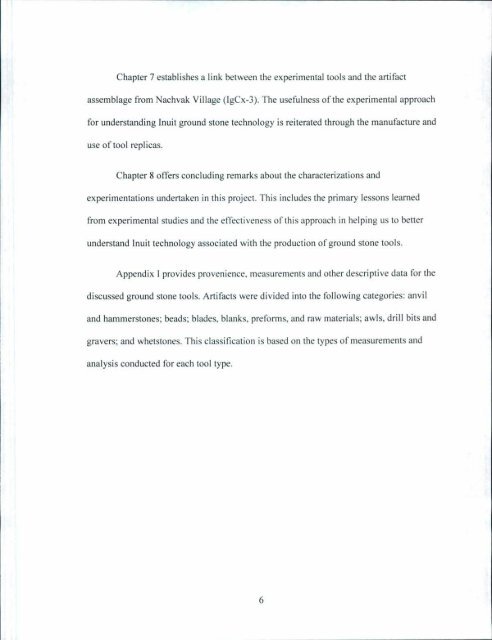- Page 5: An Experimental Approach to Inuit G
- Page 8 and 9: I would also like to thank the fiel
- Page 10 and 11: Table of Conlenls Abstract Acknowle
- Page 12 and 13: 4.2.4 Finished tools 4.3 Conclusion
- Page 14 and 15: List of Tables Table 1.1: Examples
- Page 16 and 17: Figure 4.28: Large adze blades from
- Page 18 and 19: Chapter I; Inlroduction The focus o
- Page 21: past. Such experimentation may also
- Page 25 and 26: Practicing a "modified maritime ada
- Page 27 and 28: By the time the Inuit came to Labra
- Page 29 and 30: chipped stone tools were formed wit
- Page 31 and 32: smaller than their slate counterpar
- Page 33 and 34: may be possible to eventually pinpo
- Page 35: Peter Whitridge from Memorial Unive
- Page 40 and 41: Table 2.1: Breakdown of 2003-2006 e
- Page 42 and 43: Chapter 3: Theorelical Framework Th
- Page 45 and 46: While following the described produ
- Page 47 and 48: manufacture. While some stress the
- Page 49: 3.4 Cognition and the Constellation
- Page 53 and 54: Fitzhugh 1980). The Inuit propensit
- Page 55: The drilling technique required to
- Page 58 and 59: additional thought processes that m
- Page 60 and 61: Chapler 4: Ground Stone Tool Descri
- Page 63 and 64: ,_ manufacturing anvil 0.0 0.0 0.0
- Page 67 and 68: 4. I. I. I Weapon Blades Weapon bla
- Page 69 and 70: All more or less triangular in shap
- Page 71: 4././.1.2 Lance End Blades Much lar
- Page 74 and 75:
distinguished from the harpoon head
- Page 76:
difTerent sizes and styles for difT
- Page 80:
g Figure 4.9: Large uluit, baleen s
- Page 84 and 85:
d Figure 4.13: Ground slone blanks
- Page 86:
dry while cutting the whale and hau
- Page 89 and 90:
appear too thin and brittle to have
- Page 92 and 93:
2001: 142), it also enabled the Inu
- Page 94 and 95:
the same time providing a natural i
- Page 98:
z Figure 4.22: Drill bilS, awls and
- Page 102 and 103:
technique" (LeMoine 1997:25). This
- Page 105 and 106:
Figure 4.29: Alternative use of 'la
- Page 107 and 108:
Figure 4.30: Small adze blades, bea
- Page 109 and 110:
On average. the nephrite beads are
- Page 112:
Once a portion ofslate is deemed su
- Page 116 and 117:
As wilh flintknapping ofcherts and
- Page 118 and 119:
4.2./.3 Whelslones The Concise Oxfo
- Page 120 and 121:
High numbers of line grained whetst
- Page 122:
4.2.1.3.2 Distribution ojWhetstones
- Page 128 and 129:
Whetstones were separated by estima
- Page 130 and 131:
While seven slabs of unworked slate
- Page 132 and 133:
can reveal much about the manufactu
- Page 134 and 135:
smallest, most abundant type of fla
- Page 137 and 138:
lade. If found individually. scatte
- Page 139 and 140:
Looking at analogous examples of ne
- Page 141 and 142:
performing the same function as wat
- Page 143 and 144:
incredible toughness and ability to
- Page 145 and 146:
1975). Three areas on the island of
- Page 147 and 148:
Figure 5.2: Partially worked nephri
- Page 150 and 151:
when they are broken from a larger
- Page 154:
show extensive polish on at least o
- Page 158 and 159:
available to the tool maker. Recogn
- Page 160 and 161:
One ofthe problems that plague expe
- Page 162 and 163:
implements. For this initial foray
- Page 164 and 165:
mechanical sander was useless. and
- Page 166 and 167:
6.4.4. J Experiment 5: Preform Prod
- Page 168 and 169:
I was clearly doing something wrong
- Page 170:
pressure was also applied to the wh
- Page 174:
manufacture. Larger nephrite drill
- Page 177 and 178:
and used in this test, rather than
- Page 179 and 180:
String: The sIring needed to be coa
- Page 181 and 182:
I. An initial groove was made in ea
- Page 183 and 184:
alternatively the material being wo
- Page 185 and 186:
forms, tools and debitage. it is ea
- Page 187 and 188:
essentially immutable, namely worki
- Page 189 and 190:
products and finished tools shows t
- Page 191 and 192:
to finished tool fleshes out the ch
- Page 193 and 194:
eventually be able to minimize such
- Page 195 and 196:
lithic assemblages. The chaine opCr
- Page 197 and 198:
DitTerences in the media being dril
- Page 199 and 200:
nephrite use may also lead to a bet
- Page 201 and 202:
An experimental approach cannot be
- Page 203 and 204:
needed, once again requiring the to
- Page 207 and 208:
Dobres, Marcia-Anne 2001 Meaning in
- Page 209:
Jeske. Roben 1992 Energetic Efficie
- Page 215 and 216:
Whitridge, Peter 1999 The Construct
- Page 217:
An Experimental Approach to Inuit G

















